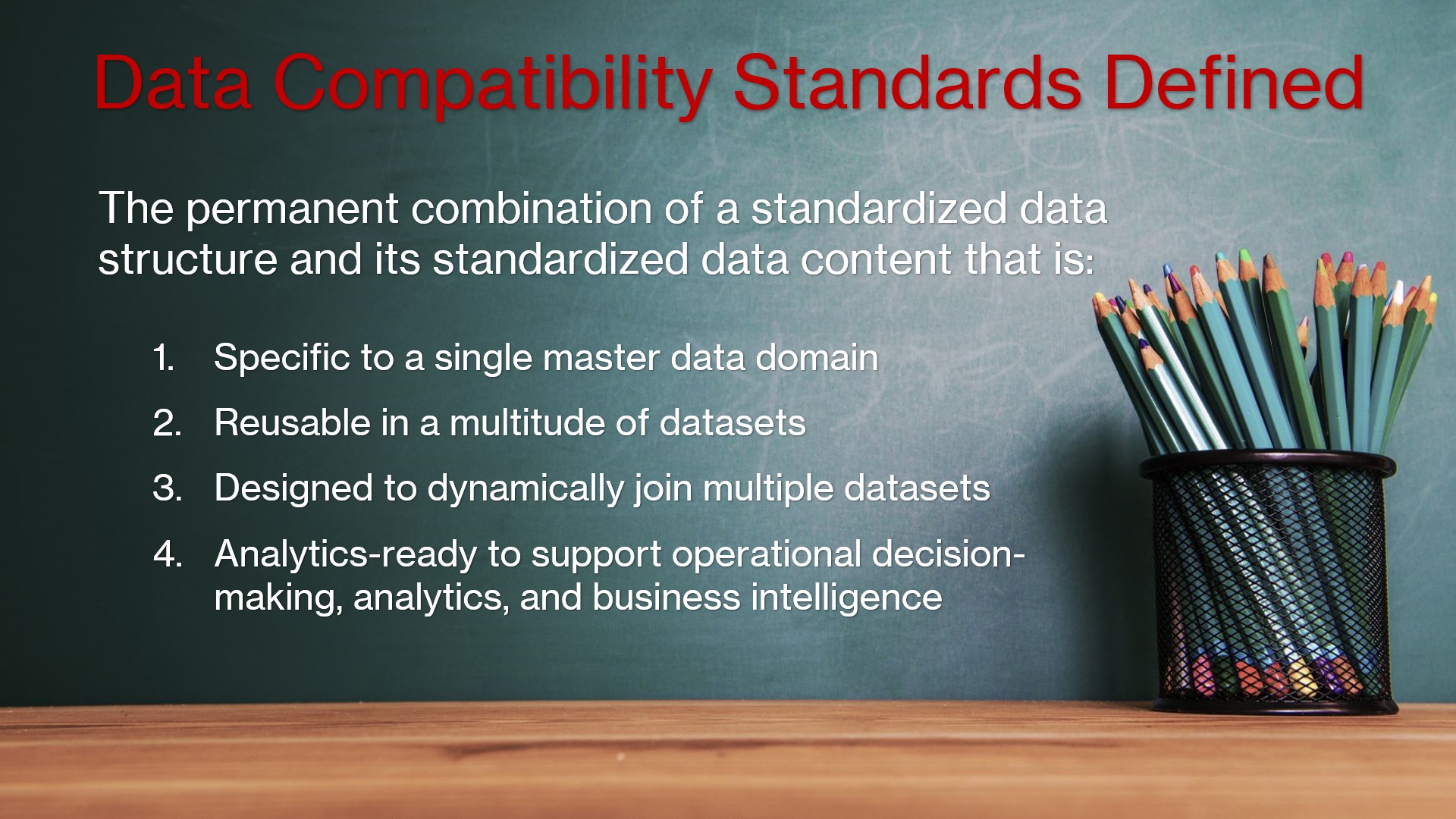A Data Solution for a Data Problem
Maxxphase's Data Compatibility Standards are standardized data model objects that can be added to any data model. These standards provide a common framework for any data model and result in the formation of a compatible data model. These Data Compatibility Standards are specifically designed to impart multiple advanced data functions into any compatible data model.
When compatible data models are instantiated, the resulting compatible datasets are directly interoperable and best characterized as analytics-ready modular plug-and-play datasets. In combination, compatible datasets spontaneously form a compatible data fabric.

A Definition of Maxxphase Data Compatibility Standards Products
An Introduction to Data Compatibility Standards Products
Our solution to the disparate dataset problem is to enrich each dataset with the proper combinations of Data Compatibility Standards. Each of the Maxxphase Data Compatibility Standards products is designed specifically for a single master data domain such as PRODUCTS or POSTAL ADDRESSES. Determining the proper combinations for each dataset is as easy as determining the master data domains used in a specific dataset. Each of the Data Compatibility Standards is designed to be reusable and is used in many datasets. Also, each Data Compatibility Standard is designed to dynamically join with copies of itself across datasets on demand. These dynamic joins are characterized as plug-and-play since they are immediately available. Finally, each Data Compatibility Standard contains a standardized data hierarchy designed to deliver data warehouse functionally individually or collectively across multiple compatible datasets.
What are the Maxxphase Data Compatibility Standards?
Data Compatibility Standards are data products provided by Maxxphase. When these standards are noninvasively associated with a dataset, the dataset is now compatible. Compatible datasets link together to form a single consistent Compatible Data Fabric. This data fabric can seamlessly support the data needs for an entire business.
From a technical perspective, data compatibility standards are platform-independent, reusable data modeling objects used to build compatible data models. Each compatible data model is an integral component of a single consistent model of your business’s integrated data architecture. This integrated data architecture may also include as components the compatible data models from external organizations such as strategic partners or suppliers.
Compatible data models are used to implement compatible data systems, which are directly interoperable and that support Standards-Based Data Integration. The data of any compatible data system may be directly and dynamically combined with the data of any other compatible data systems. Therefore, the scope of an organization’s integrated data architecture is unlimited, so long as compatible data systems are available.
Using Data Compatibility Standards
Using Maxxphase Data Compatibility Standards is simple: just include the standards in any physical data systems to make these systems compatible with each other. The standards “link” your data systems together while preserving your business data and your data structures. These “linked” physical data systems form a seamlessly collaborative Compatible Data Fabric that automatically integrates data across your “linked” data systems.
Data compatibility standards can be applied for many uses, including:
- Automatically integrating all your organization’s data
- Integrating data from the lowest level transactions of your operational data systems, to the aggregate data of the CEO’s dashboard, and everything in between
- Making all your data systems directly interoperable and collaborative
- Providing the functionality of a data warehouse to each compatible data system
- Building a seamless Compatible Data Fabric, where all your data and information is available whenever and wherever it’s needed
- Linking to compatible data systems from other organizations while operating within their security constraints.
Data Compatibility Standards allow you to incrementally build your Compatible Data Fabric to integrate data across all your compatible data systems.
How do Maxxphase Data Compatibility Standards work?
Data Compatibility Standards improve a business’s access to data and information. When data systems are made compatible, the information each system contains is automatically integrated with the data from other compatible data systems. This includes operational or transactional data systems, master data management systems, business intelligence systems, and content management systems. All data from all compatible data systems are directly accessible and may be used in whatever combinations are possible.
From a technical perspective, the Maxxphase Data Compatibility Standards form a common foundation that can be associated with any data system. This common foundation makes a data system compatible. Any compatible data system can be seamlessly linked with any other compatible data systems through their copies of the common foundation. All data from a compatible data system is directly or indirectly related to that foundation. Therefore, any data within the compatible data system is related to any other data in any compatible data systems. This approach overcomes the compartmentalized data of traditional data systems.
The Data Compatibility Standards also form reliable data access paths between compatible data systems. These access paths make compatible data systems directly interoperable and support joining data from multiple compatible data systems. These copies of the common foundation form a single network of collaborative data systems, which builds your business's Compatible Data Fabric. All of your data, stored as if it existed in a single consistent environment, contains any and all the data business leaders need to run and grow their organizations.

